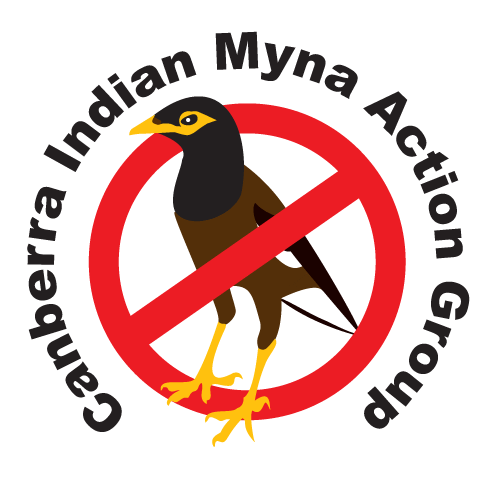What You Can Do
Below we have detailed actions that can be taken by members of the community, by government agencies and by businesses.u00a0 Each can play a part in getting on top of this pest.
Community: What can we do about this undesirable invader?
Some simple things include:
- participate in the CIMAG humane trapping program (Request a Trap, Trap Plans, Trapping Help Sheet, Protocol on Animal Welfare)
- for people outside the Canberra and Queanbeyan region, who want to be involved in a trapping program in their area, a contact list for similar community-action groups to CIMAG is here (contact list). If your area is not listed, it is suggested you contact your local council as many now have programs to support myna control activities by their ratepayers.
- not leaving cat and dog food out in the backyard during the day for mynas to take
- use a treadle feeder for your back yard chooks to prevent birds and vermin from accessing the feed
- making public areas such as shopping centres, restaurants and cafes much less attractive to mynas by not leaving food around
- refrain from feeding birds in public areas, which can have the unfortunate effect of attracting even more pest birds to the area and destroying public amenity
- planting more shrubs in gardens to reduce open areas that mynas prefer
- avoid planting tall thin trees with dense foliage such as pencil pines which flocks of mynas use for roosting at night
- check your roofs for any holes or entry points and block them to prevent entry by mynas, making sure at the same time that you havenu2019t accidentally imprisoned a possum or other native resident
- cover food scraps / waste at home u2013 secure bins, donu2019t leave bags of food waste out
- keeping stock feed in rural areas secured away from mynas
- encourage friends and acquaintances to be involved
- write to the local MLAs pressing them for a detailed and practical Management Plan as the follow-up to the Declaration of Indian Mynas as Pest Animals.
Government: What can it do about this Declared Pest Animal?
Government Agencies
Government buy-in to myna control is essential. The ACT government has made an important first step by declaring the Indian Myna a pest species. But further actions along the lines listed below is also needed:
- A basic step is for the ACT Government to develop a detailed and practical Pest Animal Management Plan as follow-up to the Declaration
- Schools: Mynas pose a health risk to children at school through their droppings and fecal dust which can contain pathogens and viruses. Accordingly, schools, public and private, should be required to undertake myna reduction programs to help reduce the risk. This strategy could encompass litter and food scrap management during school terms and trapping activities during school holidays. A trapping program could be operated by school janitors.
- Parks and Conservation: Parks and Conservation Services could help educate the ACT community of the environmental damage caused by mynas and undertake control activities on public land in Canberra Nature Reserves. This is particularly pressing in those Natures Reserves such as Goorooyaroo – which are breeding sites for the Superb Parrot which are likely to be under competition for breeding hollows from mynas.
- Parks and Conservation Services depots could establish euthanizing stations to enable trapped mynas to be disposed of for trappers unable to dispose of trapped birds at home.
- The RSPCA could be required, as part of their obligations for receiving ACT Government annual support funding, to offer a disposal service to those community trappers unable to euthanize trapped birds at their residence.
- Correctional Services: there should be a resumption of myna trap-making activity for CIMAG by inmates as a prisoner rehabilitation program in the Alexander Maconochie Centre. As with traps made by people under Community Services Orders, these traps could then be provided to CIMAG for distribution to community members as part of the CIMAG community-action trapping program. In concert with this, it would be appropriate that the ACT Government funded the supply of materials for the construction of traps.
- Building Design: the building code should be modified to require new homes and commercial building to include exclusion barriers into roof cavities, to avoid entry by mynas for nest building.
Business: What can it do to support the effort?
Eateries: Mynas congregate around eateries because of food scraps on outside tables and food waste in open restaurant skips. This poses human health risks to patrons and provides easy food for mynas. Restaurant and cafe owners / managers should ensure that outside restaurant and cafe tables are promptly cleared of food scraps and that restaurant skips are covered. No food waste should be left in exposed outside areas for mynas (or other birds) to scavenge.
Shopping Centres, Industrial Precincts: Businesses owners of shopping complexes, or industrial estates, should discourage
the congregation of mynas by eliminating food scraps and by modifying potential roosting sites: the latter may most readily
be achieved with bird spikes or similar. Rubbish bins should be modified to stop access by scavenger birds. Certain large shopping complexes and industrial estates are amenable to a discrete trapping program where traps operate away from
public view.
